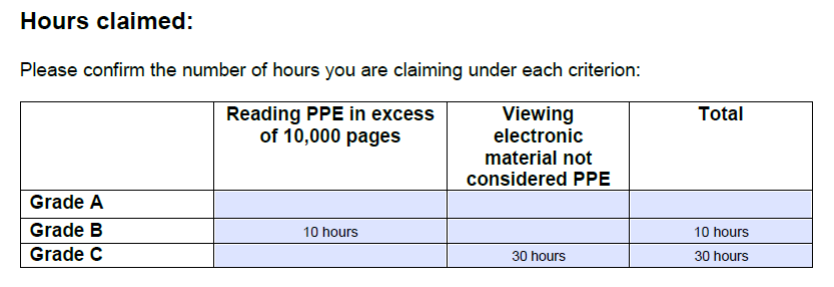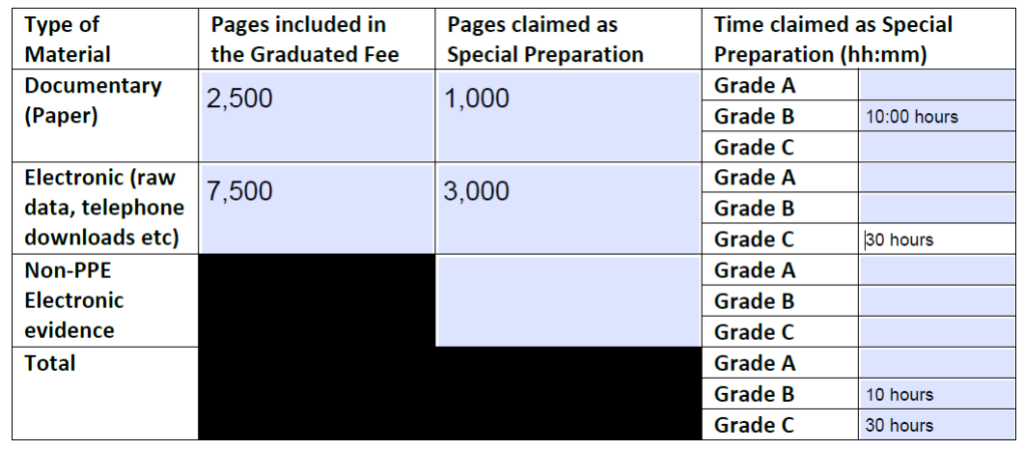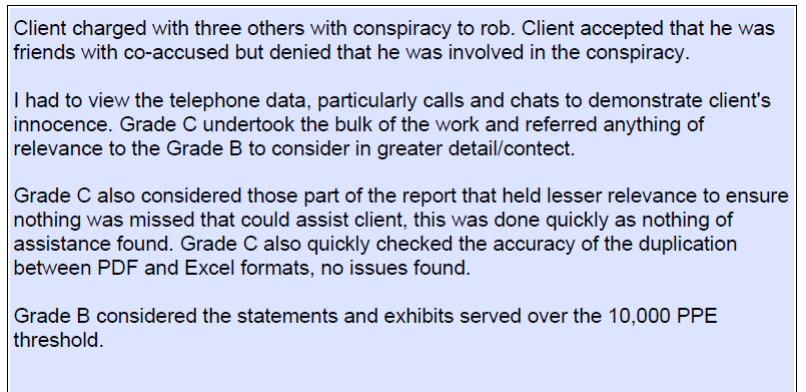Completion of the Form
You should download the most up to date version of the LSP2 form from GOV.UK.
Section 1 – Case details
In this section you need to input your provider number and the MAAT number for the case. The MAAT number can be found on the original representation order.
Below is an image of Section 1 of the form. It contains a space for the provider number, the MAAT number and a tick box to confirm that the work detailed in the claim has not been requested for remuneration elsewhere.

Section 2 – Hours claimed
In this section you need to detail the number of hours special preparation claimed by each grade and under each criterion.
The table in section 3 Contains four columns and four rows.
The second column ask how much time is spent considering evidence served in excess of the 10,000 PPE cap.
The third column asks how much time is spent considering the electronically served evidence.
The final column records the total time claimed per grade.

In the example above:
- no time is claimed at Grade A – the second line is therefore empty
- 10 hours are claimed at Grade B to read pages served in excess of the 10,000 PPE threshold
- 30 hours are claimed at Grade C to consider the electronically served evidence
Section 3 – Fee Earner Details
In this section you need to provide details of each fee earner who has undertaken unused preparation in this case. You need to confirm:
- the fee earners names
- the Grades of the fee earners – there is a drop-down menu contained within the table to assist with selection
- how the fee earners meet their Grades; and the reasons for undertaking preparation of the case (only applicable if claiming Grade A or B)
Below is an image of section 2 of the unused preparation form. It contains three columns, name of fee earner, Grade, and “if claimed at litigator rate A or B, please confirm how this grade is met and the reasons for undertaking preparation at this Grade”.

In this example there have been two entries in the table.
The first row contains the fee earner name “B Fee Earner” in column one, the Grade of the fee earner has been entered using the drop-down box of which “Grade B” has been selected in column two. The third column contains the following information to support the Grade of fee earner “Admitted on 15/9/2016. Considered served documentary evidence”.
The second row contains the fee earner name “C Fee Earner” in column one, the Grade of the fee earner has been selected as “Grade C” in column two. The third column contains the text “Considered raw data”.
Please enter the fee earner name as it appears on either the Law Society or CILEX website. If the fee earner is a qualified solicitor, please include the date they were admitted. This helps us to correctly verify their Grade.
Section 4 – Supporting evidence checklist
For all claims, you must provide:
- indictment – this tells us what your client is charged with and the time frame of the offences
- case summary – this gives us detail as to the case against your client
- LAA report and/or NAEs – this allows us to verify the page count and the service of electronic evidence
- work log or attendance notes – this gives us detail of what evidence you are viewing, how many pages were considered (if applicable), how long you spent considering the material and if anything of relevance was found
For all claims with electronic evidence, you must provide the electronic evidence to us via the Secure File Exchange (SFE) for consideration.
Section 5 – Claim detail
In this section you need to provide details of the nature of the evidence considered including but not limited to:
- documentary evidence such as witness statements, documentary exhibits, ROTIs
- electronic evidence such as telephone download reports, raw data
- non PPE electronic evidence
- the time spent considering the material
- the grade who considered the material
Below is an example of section five of the claim form. It is a table which has three columns and three rows.
The first row asks you to detail the number of pages of documentary served evidence claimed within the graduated fee and the number of pages claimed as special preparation. You also need to confirm how many hours are claimed for this consideration and at which grade.
The second row asks you to detail the number of pages of electronically served evidence claimed within the graduate fee and the number of pages claimed as special preparation. You also need to confirm how many hours are claimed for this consideration and at which grade.
The third row asks you to detail the number of pages of non-PPE electronic evidence claimed as special preparation. You also need to confirm how many hours are claimed for this consideration and at which grade.

In the example above the solicitors are claiming:
2,500 pages of documentary evidence within the graduated fee
1,000 pages of documentary evidence as special preparation – 10 hours are claimed at Grade B
7,500 pages of electronic evidence within the graduated fee
3,000 pages of electronic evidence as special preparation – 30 hours are claimed at Grade C
Section 6 – Electronic evidence
This section is only to be completed if your claim for special preparation includes electronic evidence. You must provide detail about the electronic evidence. Below is an example of the detail required.

In the example above, solicitors have stated:
CPS served 4 full telephone download reports.
Three of the reports were served in PDF format and one was served in Excel format.
One PDF report (NCB1) is duplicated in Excel.
When considering the PDF reports, I focused on the relevant sections (calls, chats,
messages and the relevant images) in greater detail. I also focused on key dates set out in the prosecution case summary, then considered the surrounding dates to check context/patterns.
For NCB1, the Excel document was considered, key word searches and filters were
used to check the evidence efficiently. A quick check was made of the PDF version to ensure accuracy in the duplication.
Section 7 – Background information/justification
In this section you are able to provide background information and justification for your claim. It is very important that you provide an overview of the case against your client, key evidence against your client and why the time you are claiming is reasonable. Below is an example of the detail required for a lower value claim.

In the example above, the solicitors have stated:
Client charged with three others with conspiracy to rob. Client accepted that he was friends with co-accused but denied that he was involved in the conspiracy.
I had to view the telephone data, particularly calls and chats to demonstrate client’s innocence. Grade C undertook the bulk of the work and referred anything of relevance to the Grade B to consider in greater detail/context.
Grade C also considered those part of the report that held lesser relevance to ensure nothing was missed that could assist client, this was done quickly as nothing of assistance found. Grade C also quickly checked the accuracy of the duplication between PDF and Excel formats, no issues found.
Grade B considered the statements and exhibits served over the 10,000 PPE threshold.
Litigators special preparation hourly rates
| Grade | Outer London | London |
|---|---|---|
| A | £48.36 | £50.87 |
| B | £41.06 | £43.12 |
| C | £27.15 | £31.03 |